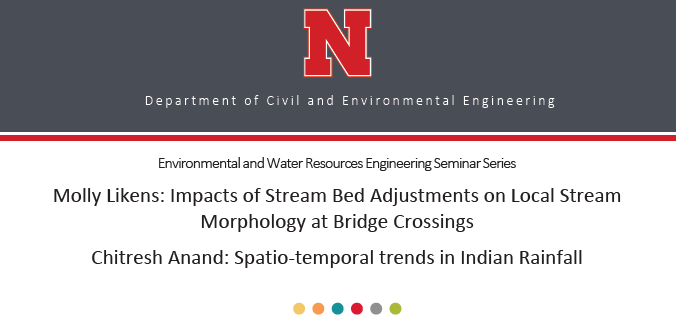
Who: Molly Likens and Chitresh Anand
When: May 3rd at 11:00am
Where: A445 KH (Lincoln), 160 PKI (Omaha)
Molly Likens: Impacts of Stream Bed Adjustments on Local Stream
Morphology at Bridge Crossings
Abstract: Nebraska sand-bed rivers have long been a part of sediment transport studies and have been used in the development of numerous well-known empirical bedload equations. Some of these studies have shown how adjustments in streambed elevation led to changes in local stream morphology. The sand-bed rivers of Nebraska are highly susceptible to such changes due to their wide, shallow cross-sections and erodibility. The objective of our study is to synthesize a hydrodynamic model with high resolution field data and improved methods of representing sediment transport to better predict both short and long-term channel adjustments for an aggravated sand-bed river. The field component of our study targets reaches of the Niobrara River in northern Nebraska near two bridges, the Highway 11 bridge and the Highway 281 bridge. These reaches are of particular interest because they are situated upstream and downstream of a dam that failed in 2019, releasing large quantities of sand into the downstream reach. We used digital elevation model (DEM) data from United States Geological Survey (USGS) and HEC-RAS 2D to create base models of the two reaches. These models will be refined with recently collected Unmanned Aerial System (UAS) data that provides us with Digital Terrain Models (DTMs) and aerial photos (for roughness estimation) of the sites. The UAS data will be updated over the course of the project to reveal temporal changes in the topography of the reaches. All of the data are being incorporated in the HEC-RAS 2D model to assess model performance and to adjust the model to optimize short-term predictions.
Chitresh Anand: Spatio-temporal trends in Indian Rainfall
Abstract: The Indian rainfall pattern exhibits notable spatial heterogeneity and temporal variability, influenced by changing climate conditions and global warming. Despite extensive studies in the literature, there remains a lack of consensus regarding trend patterns in Indian rainfall. This study aims to analyze spatial and temporal trends in rainfall across the Indian landmass, focusing on the effects of data resolution on trend analysis. Utilizing daily rainfall data from the India Meteorological Department (IMD), both parametric and non-parametric tests are employed for trend detection, considering potential differences in methodologies. Results indicate that while varying data resolutions yield different outcomes, methodological differences also significantly impact trend results. Specifically, a cluster of grid points spanning central and eastern Indian landmass exhibits a notable decreasing trend, identified through field significance testing. Additionally, trends derived from rain gauge data are compared with those from gridded data, revealing the complexities introduced by missing values in rain gauge datasets. Ultimately, the study underscores the importance of
meticulously selecting datasets and trend analysis tools to accurately discern trends in rainfall data.